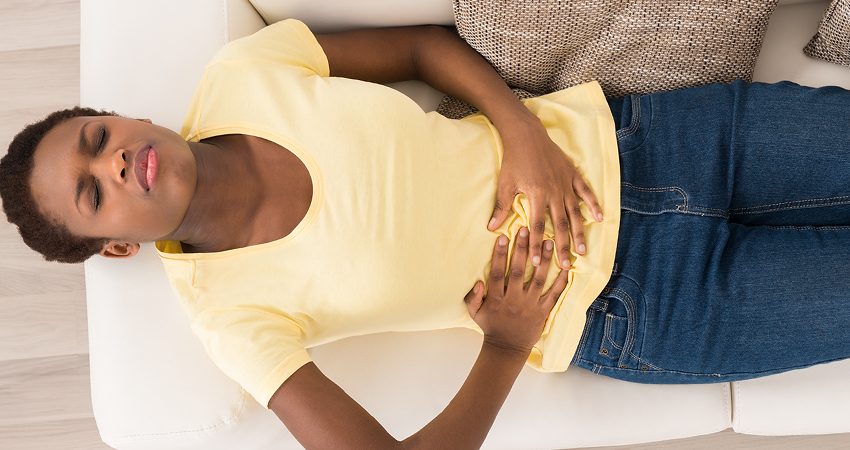HOW WILL FIBROIDS AFFECT MY LIFE?

Amaka returned from the bathroom with a towel wrapped tightly around her chest. It was a refreshing shower, but she had other things on her mind. Over the past few months, she had noticed her tummy had increased quite a lot in size. She had been eating just normally, and doing the most at working out to burn off any excess abdominal fat, but over the past few months, her abdominal area had grown bigger and bigger anyway.
Letting her towel slide down all the way to her hips, she observed her image in the mirror, her eyes settling around her abdomen. With the back aches and frequent urination, she may have easily started to think she was pregnant, but she definitely wasn’t pregnant. For one, she hadn’t had intercourse in the past 2years since her last boyfriend, Eze, had dumped her some weeks before her 32nd birthday, for a much younger lady, after they had dated for 6years.
Besides that, she knew she couldn’t be pregnant because her menstrual periods were still regular, though abnormally heavy, and more painful than before. A few days later, Amaka finally decided to check in with a doctor in a nearby hospital, and she was diagnosed with uterine leiomyoma, commonly called fibroids.
WHAT IS FIBROID?
A fibroid, also known as a leiomyoma, myoma, uterine myoma or fibroma is an abnormal growth (tumor) that develops in or on a woman’s uterus (womb).
Sometimes, these tumors become quite large and can cause severe abdominal pain and heavy bleeding. They are not cancers, but are simply made up of smooth muscle cells, and develop during a woman’s childbearing years.
WHAT ARE THE TYPES OF FIBROIDS?
Fibroids are grouped based on the position, whether they grow inside the womb, within the wall of the womb or on the womb.
HOW COMMON IS FIBROID?
Fibroids are one of the most common gynecological diseases in women at reproductive age.
They are usually commoner in women of African-American origin.
Research in 2013 showed that an estimated 171 million women worldwide were affected by fibroid.
About 40-60% of women have fibroid by age 30, and about 20-80% of women develop fibroid at the age of 50. They are typically found during the middle and later reproductive years.
WHAT MAKES A PERSON LIKELY TO GET FIBROID?
The exact cause of fibroid is not known, however, theories suggest that it originates from the interaction between the female hormones, estrogen and progesterone, and the inner lining of the womb.
However, several risk factors (factors that may make a woman more likely to have fibroids have been identified). Some of these include:
- Age: Older women are more likely to develop fibroids. It is most common in women from the ages of 30-40 years.
- African American race: Women of African American race are more likely to have fibroids than women of other races.
- Obesity: Women who are obese or overweight are also more likely to develop fibroids
- Family history of fibroids: Women who have relatives like mother, sibling or aunt who have had fibroid are more likely to have fibroid themselves
- No previous pregnancy: Women who have had no pregnancies in the past are also more likely to develop fibroid. As a common saying in medical parlance, “a womb without a fetus will console itself by forming a fibroid”
Factors that may lower the risk of a woman developing fibroids may include:
- Pregnancy: the risk of having fibroids decreases with an increase in the number of pregnancies
- Long term use of oral/injectable contraceptives.
HOW DO I KNOW IF I HAVE A FIBROID?
A woman with fibroids may have no symptoms at all and the fibroids may only be discovered during other routine medical or surgical procedures for other reasons.
However, the general symptoms that may make one suspect the presence of a fibroid include:
- Heavy menstrual bleeding.
- Prolonged menstrual periods.
- Pain in the lower abdomen, which may be serious or not so serious.
- Bleeding in between periods, also called spotting, this may be a lot of blood or just a little.
- Increased menstrual cramps than what used to be experienced before.
- Pain during intercourse.
- Swelling or enlargement of the abdomen.
Your doctor will be in a better position to make a diagnosis after a proper medical examination. You may also need other tests like;
- An ultrasound scan
- A pelvic MRI(Magnetic Resonance Imaging)
HOW ARE FIBROIDS TREATED?
Your doctor will tell you what kind of treatment you will need, depending on your age, the size of the fibroids, whether or not it occurs during pregnancy, and your health status.
Based on this,you may be treated by:
- Drugs.
- Surgery, which involves getting into the womb and removing the fibroids or removing the entire womb where necessary, and especially in women who no longer wish to have children.
- A combination of both drugs and surgery.
- If the size of the fibroid is small, and there are no symptoms, no treatment may be required.
- No, herbal mixtures such as “Goko cleansers” won’t help to cure fibroids.
HOW WILL HAVING FIBROIDS AFFECT MY LIFE?
Leiomyoma uteri (fibroids) are not directly life threatening, though if left untreated over a long period, some complications may arise. Many women will still get pregnant even with fibroids, and some may develop it during pregnancy. Although in some women, the presence of a fibroid may make it more difficult to get pregnant.
Having health insurance makes the journey easier, you can go for consultation, get proper diagnosis and treatment.
At the end of the day, the outcome of treatment depends on the size and location of the fibroid, but the outcomes are generally good.

